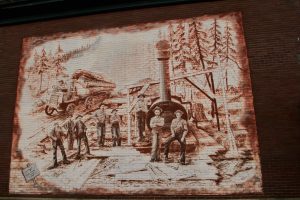Logging is an iconic blue-collar industry of Washington State. When the new machines that improved safety and efficiency to the logging industry were introduced during the onset of the 90s, they replaced the work that used to take two men to accomplish. In Skagit County two men, Ray Jarmin and Andy Hawkings, remember the glory days of logging.

Ray Jarmin was born in Stanley, North Dakota in 1940. His family moved to Rockport when he was three-years-old because his dad cut ties for the railroad back then. “I loved my childhood,” Ray says. “I used to ride the ferry.” He is referring to a relic at Howard Miller Steelhead Park that carried people across the Skagit River in Rockport back in the day. “My friend lived in the cabin for the ferry,” he adds. By the time he was 18-years-old, Ray began working at the shake mill at the end of Peterson Bridge. When he was 19-years-old, Seattle City Light asked Ray to make beds and keep the stoves warm in Newhalem at the Ross Lake logging camp. He says his work schedule was “10 days in and 4 days out.”
After being laid off for the winter, Ray was re-hired by the Ross Lake Power House for three years as a painter’s assistant. At this job he used lacquer 32 solvent to clean grease off generator arms, which led to him developing claustrophobia. “I did not like hearing the 60 hums per cycle in the generator,” Ray recalls. “So I went to work with my uncle logging in the woods.” It only took two months before Ray decided to leave his uncle’s employment, which kicked off a long career with numerous companies as a logger after that.

Andy Hawkings, born in Concrete in 1956, also got his start with logging through family. “I was born in to it,” he says. “My dad owned a business, H & W Logging.” Andy’s dad gave him his first chainsaw when he was 14-years-old. Andy grew up on 40 acres of land using his trusty Homelite chainsaw and tractor cutting firewood as a teen and going to work with his dad until he was a legal 18-years-old in 1974.
Andy and his dad’s partner didn’t get along, so when he reached legal age he went in to the service for three years. He was stationed in Georgia State, Hawaii and New Zealand during his time in the army. Then from 1978 in to the 1990s Andy went back to “logging every summer and monkey-wrenching in the winter,” as Andy puts it.
Once machines replaced half the men working, Andy’s employers “figured out I was better at fixing things than I was at logging,” he explains, which set a new course for Andy’s career as a mechanic.
As career loggers both Ray and Andy worked as “hook tenders.” “We were the boss on one side who packed blocks, strung high lead roads, lay where the yarder goes, and rigged the tree not just the stumps,” Andy explains.
If you’re not familiar with logging terminology a yarder is a device that “brings logs down the mountain without touching the ground, creating a high lead road,” explains Ray.
“Two logs bolted together like a beam system, with a flattened part and set yarder on top,” Andy elaborates. This method, invented in the 6os by Rankins in Darrington, helps prevent groundhogging. Ray explains that this term was used to describe tearing up the earth, something that gave loggers a bad name.
On that note of environmentalism, Andy explains logging was more prevalent in old growth forests back in the day. “An older, bigger tree makes plywood better because there are less knots in the wood and there’s more of it,” he continues. Alder trees, a common second growth species, were seldom logged because the equipment could not get into the tightly spaced alder groves. “Nowadays they log a lot of second growth, with more knots, they’re smaller, it creates a less good product. I keep telling people, logging is a crop, it just takes longer to develop than corn. It takes 35-40 years instead of 90 days.”
Ray managed to list no less than five logging companies that employed him throughout the years, if not more. Andy described loggers as gypsy-like. “We went between companies for 7-8 months out of the year,” he shares. Snow in the mountains during the winter caused a lot of regularly laid-off loggers. Sometimes, however, loggers would request time off if there was a better paying job available. For example, Ray wanted to collect pinecones for the federal government, which needed to extract the seeds to grow trees and paid more than the logging companies. When he couldn’t get the time off, he quit so he could make more money. He knew he could always go to a different logging outfit or return to the shake mill or cut brush or any other number of jobs available back then.

Due to the wind, gravity and elevation, “logging is dangerous,” explains Ray. “Rankin had a sky car, that thing was hilarious. The sky car is a remote-controlled carriage that dropped lines to loggers on a two-inch skyline cable 4-5,000 feet up in the trees.” The snubber pulled ten thousand feet of cable on a drum up and down slopes. So he’d ride the log underneath the sky car to get back uphill in 1 minute instead of walking back uphill in 25 minutes. “I used to ride underneath that sucker, it was illegal as hell,” he adds.
When you’re working with “2,000-pound logs, yeah there’s a high risk of injury,” Andy adds.
“Insurance is so expensive now,” explains Andy. These numbers might be outdated, but he estimates it costs $20 an hour to insure a machine and $8 an hour on ground, motivating logging companies to spend as little as possible elsewhere since insurance rates are so high.
Finishing that thought on safety, “There was a guy that went to school with my brother in law,” Andy reminisces, “A log got loose from the line above us, slid downhill between the two of us. He went back to school the next day and paid real close attention after that.”



































